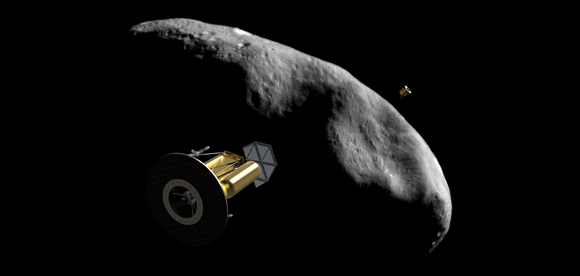
A billionaire-backed asteroid-mining company aims to start putting its big plans into action soon, launching its first hardware into space by this time next year.
Planetary Resources, which counts Google execs Larry Page and Eric Schmidt among its investors, plans to loft a set of tiny "cubesats" to Earth orbit in early 2014, to test out gear for its first line of asteroid-prospecting spacecraft.
"Our belief and our philosophy is that the best testbed is space itself," Chris Voorhees, Planetary Resources' vice president of spacecraft development, said Wednesday (April 24) during a Google+ Hangout event. [Planetary Resources' Asteroid-Mining Plans (Images)]
"Despite the fact that we're a deep-space company, we're going to use Earth orbit as much as possible," Voorhees added. "For us, it's a valuable learning experience, and that's what we plan on doing one year hence."
The cubesats slated for launch in 2014 will measure 12 inches long by 4 inches wide by 4 inches tall (30 by 10 by 10 centimeters), company officials said. These "Arkyd-3" satellites will test out technologies for Planetary Resources' Arkyd-100 scouts, which the firm hopes to launch to low-Earth orbit on asteroid-hunting missions in 2015.
The Arkyd-3 "is the testbed manifestation of our Arkyd-100 spacecraft. It just happens to be flying," Voorhees said.
A series of other robotic probes beyond the 33-pound (15 kilograms) Arkyd-100 will investigate near-Earth asteroids up close, eventually mining suitable ones for resources such as water and precious metals. Water is the key focus at first, because it is the key enabler of off-Earth living, Planetary Resources officials said.
Get the Space.com Newsletter
Breaking space news, the latest updates on rocket launches, skywatching events and more!
Water can keep astronauts hydrated, obviously, and serve as a shield against dangerous radiation. Split into its constituent hydrogen and oxygen, it can also provide breathable air and rocket fuel, allowing voyaging spaceships to fill up on the go.
Sourcing water in space will make space travel much cheaper and more efficient, Planetary Resources president Chris Lewicki said, noting that it currently costs about $10,000 to launch 1 liter (0.26 gallons) of water to low-Earth orbit.
"Water is the gateway drug of space. It's the enabler — in a good way, though," Lewicki said.
Planetary Resources held Wednesday's Google+ Hangout partly to mark the one-year anniversary of the company's public unveiling. After Planetary Resources announced its existence and intentions last year, another asteroid-mining firm called Deep Space Industries made its presence known as well.
Both companies hope their activities help spur humanity's push out into the solar system, officials have said.
Follow Mike Wall on Twitter @michaeldwall and Google+. Follow us @Spacedotcom, Facebook or Google+. Originally published on SPACE.com.
Join our Space Forums to keep talking space on the latest missions, night sky and more! And if you have a news tip, correction or comment, let us know at: community@space.com.

Michael Wall is a Senior Space Writer with Space.com and joined the team in 2010. He primarily covers exoplanets, spaceflight and military space, but has been known to dabble in the space art beat. His book about the search for alien life, "Out There," was published on Nov. 13, 2018. Before becoming a science writer, Michael worked as a herpetologist and wildlife biologist. He has a Ph.D. in evolutionary biology from the University of Sydney, Australia, a bachelor's degree from the University of Arizona, and a graduate certificate in science writing from the University of California, Santa Cruz. To find out what his latest project is, you can follow Michael on Twitter.









